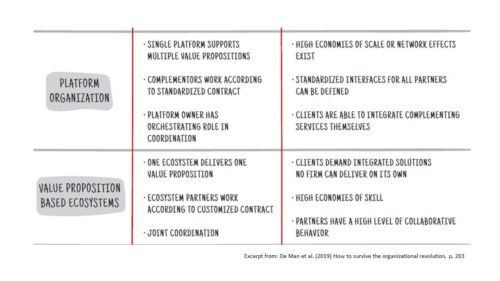Platform ecosystems (6): Platforms vs value prop ecosystems
This is part six of seven blogs on platform ecosystems. All blogs can be found on Blogs – Organizational Revolution
A constant source of confusion is that the word ecosystem is applied to anything and everything. One of the most important distinctions for companies is the difference between a platform ecosystem and a value proposition ecosystem. The main focus of this blog series is on the former. Platform ecosystems however earn their money from value proposition ecosystems built on the platform. The figure below shows the main differences. It is part of a table comparing new organizational forms from my book with Pieter Koene and Martijn Ars How to survive the organizational revolution (https://amzn.to/3tRWj2e). A value proposition ecosystem is a set of companies collaborating and innovating around a specific value proposition for a client or a market segment. Think about HP, Nvidia, Dassault Systèmes, VMWare and Ansys who jointly deliver virtual desktops to Honda. Or International SOS that may combine services from Uber, AirBnB, hospitals and psychologists to support expats. B2B platforms like those supported by IBM, Microsoft or SAP offer all kinds of technologies. System integrators combine them with other technologies to deliver a value proposition to their clients. Whereas one platform may support multiple value propositions, a value proposition based ecosystem supports only one.

The dynamics of managing these value proposition ecosystems differ from managing platforms. In fact it is more akin to managing multipartner alliances. In value proposition ecosystems companies work according to customized contracts and engage in joint coordination around their solution. Note that most platforms have value proposition ecosystems, but that value propositions ecosystems may function without a platform.
With Alliance Best Practice and Trident I am working on a system to assess the maturity of value proposition ecosystems. Elements we consider relevant are:
– Strategy: What is the vision behind the value proposition ecosystem?
– Culture: To what extent are value proposition ecosystems embedded in your company mindset?
– Process: How fast and how good are you in managing value proposition ecosystems?
– Enablement: How do you support the go-to-market of your ecosystem?
– Control: What is the governance model for the ecosystem?
– Structure: Is there clarity about who does what in your ecosystem?
As you can see, these elements differ substantially from what makes a platform ecosystem successful. For instance, the level of human interaction is much higher and the level of standardization much lower. Because much of the value of platforms is generated by value proposition ecosystems, they need to build up skills in managing them.
About this series
In a series of seven blogs I give my view on the ins and outs of managing platform ecosystems. I will discuss the four challenges of managing platform ecosystems, what companies do to overcome the challenges, a model for the governance of platform ecosystems, modelling ecosystems through value maps, how value proposition based ecosystems relate to platform ecosystems and when to opt for a closed or open ecosystem.
All blogs can be found on Blogs – Organizational Revolution
